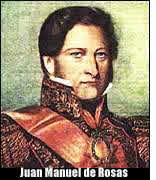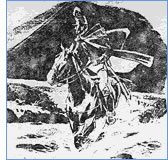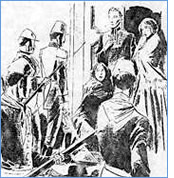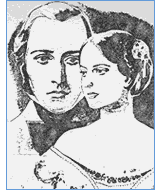 In
the early hours of the afternoon of February 3, 1852, after the defeat
and dispersion of the Federal Army and Rosas' escape from the battlefield,
Urquiza's troops entered Buenos Aires victoriously, preceded by the famous
Entre Ríos Lancers. People looked out their doors and windows to see them
pass by and to convince themselves that Rosas had fallen and the Holy
Federation had ended. In
the early hours of the afternoon of February 3, 1852, after the defeat
and dispersion of the Federal Army and Rosas' escape from the battlefield,
Urquiza's troops entered Buenos Aires victoriously, preceded by the famous
Entre Ríos Lancers. People looked out their doors and windows to see them
pass by and to convince themselves that Rosas had fallen and the Holy
Federation had ended.
After the
battle was over, the last Federal commander, the famous Colonel Chilavert,
seated on a cannon and smoking a cigar, waited for the arrival of his
enemies. General Urquiza, with whom he had an old animosity, ordered that
Chilavert be shot immediately; the body of the brave soldier was hung
from a willow tree in Palermo where it stayed until the following day.
 Colonel
Santa Coloma, well-known for his cruelty during Rosas' time, hid behind
the altar in the chapel located in the Barracas de Belgrano (then known
as the "Alfalfares de Rosas"). He was discovered and an officer of the
liberating army who had a score to settle with him ordered that he be
taken from the sacred chapel and his throat slit. Colonel
Santa Coloma, well-known for his cruelty during Rosas' time, hid behind
the altar in the chapel located in the Barracas de Belgrano (then known
as the "Alfalfares de Rosas"). He was discovered and an officer of the
liberating army who had a score to settle with him ordered that he be
taken from the sacred chapel and his throat slit.
As Urquiza's
troops drew near, preceded by a mob which assaulted and vandalized the
houses of the people, the pastor of San José de Flores gave shelter to
women and children in the church; he stood in the atrium holding up a
crucifix and valiantly defending the sacred space.
Surrounded
by a group of soldiers who did not recognize him and who mistook him for
a Federal officer, (not noticing the insignia which identified him as
a military surgeon), the famous doctor and poet Claudio M. Cuenca was
killed as he prepared to help the wounded. The poem against Rosas that
he had written the night before as he travelled in his ambulance cart
was found among his bloody clothes.
 Gregorio
Velarde, the famous and violent Unitario, returned with the rebels from
Uruguay, full of hatred and avid for revenge and blood; he organized a
legion to persecute and to execute all the members of the Mazorca and
all Federals who had managed to incur his wrath. Gregorio
Velarde, the famous and violent Unitario, returned with the rebels from
Uruguay, full of hatred and avid for revenge and blood; he organized a
legion to persecute and to execute all the members of the Mazorca and
all Federals who had managed to incur his wrath.
 Alejandro
Miranda, the young exile who had combatted Rosas with sword and pen during
the siege of Montevideo, returned with the liberating army and went to
see his former sweetheart, Adriana Pacheco, who, together with her father
and her Federal fiancé, Olegario Mendizábal, had taken refuge in her country
house in Flores, now in the pathway of the victorious troops and the mob. Alejandro
Miranda, the young exile who had combatted Rosas with sword and pen during
the siege of Montevideo, returned with the liberating army and went to
see his former sweetheart, Adriana Pacheco, who, together with her father
and her Federal fiancé, Olegario Mendizábal, had taken refuge in her country
house in Flores, now in the pathway of the victorious troops and the mob.
A friend
and relative of Alejandro Miranda, Velarde proposes to execute Don Jerónimo
Pacheco, Adriana's father, to obtain what he calls "blood justice" . Adriana,
the beautiful porteña [resident of Buenos Aires], has never forgotten
her love for Alejandro. If Velarde kills his old enemy, a barrier of blood
will separate Adriana and Alejandro. |
